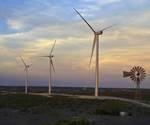U.S. wind development grows by 6,146 megawatts in first quarter
The American Wind Energy Association’s first quarter 2019 report also says the total pipeline of U.S. wind energy development has reached a record-breaking 39,161 megawatts.
Th total volume of U.S. wind power construction and development activity reached record levels in the first quarter of 2019, according to the American Wind Energy Association’s (AWEA; Washington, D.C., U.S.) newly released U.S. Wind Industry First Quarter 2019 Market Report.
AWEA reports that U.S. project developers announced new wind farms with a total capacity of 6,146 megawatts in the first quarter of 2019, which is more than the capacity of all the currently operational wind farms in California. The additional capacity brings the U.S. construction and advanced development pipeline to a record-breaking 39,161 megawatts, an 11% increase over the previous quarter. Eight states are now on track to double their installed wind capacity, AWEA says.
“With nearly 40,000 megawatts in development, America’s largest source of renewable energy generating capacity is on a path to grow by 40% in the near term,” says Tom Kiernan, CEO of AWEA. “In doing so, we’ll create thousands of additional American jobs and new economic opportunities for factory towns and rural communities across the country.”
Of the total wind pipeline, 17,213 megawatts were under construction across 21 states at the end of the first quarter, with Texas leading with 6,528 megawatts under construction — 1,255 megawatts of which is new this year. Project developers also reported 21,949 megawatts of wind capacity in the advanced development stage, which also reached a record level. Projects in advanced development have not yet begun construction but are likely to come online in the near term because they have either signed a long-term contract, placed turbine orders, or are proceeding under utility ownership, AWEA says.
In addition, the report says that a total of 841 megawatts of wind projects came online during the first quarter, elevating the country’s total installed capacity to 97,223 megawatts. Iowa led the nation in new capacity installations with 536 megawatts brought online.
According to AWEA, the industry’s strong development pipeline is feeding growing U.S. demand for low-cost, clean energy. The first quarter of 2019 saw the second strongest volume of power purchase agreements (PPAs) since AWEA began tracking procurement activity, with 2,717 megawatts of wind PPAs signed. Utilities signed contracts totaling 2,694 megawatts, led by Northern Indiana Public Service Company and National Grid. In addition, utilities announced plans to build and own 1,049 megawatts of wind in the first quarter, underscoring continued utility appetite to own and rate-base wind projects.
In offshore wind, New York Governor Andrew Cuomo announced earlier this year that the state's offshore wind goal is 9,000 megawatts by 2035, up from the previous target of 2,300 megawatts. National Grid filed for approval of a 20-year contract to buy 400 megawatts from the Revolution Wind project at a fixed price of $98 per megawatt-hour (MWh), the second offshore wind PPA to come in below $100 per MWh. In February, New York received bids from four offshore developers in response to its first solicitation for at least 800 megawatts of offshore wind.
Read CW’s news coverage of AWEA’s 2018 wind energy findings
Related Content
-
Collins Aerospace to lead COCOLIH2T project
Project for thermoplastic composite liquid hydrogen tanks aims for two demonstrators and TRL 4 by 2025.
-
Infinite Composites: Type V tanks for space, hydrogen, automotive and more
After a decade of proving its linerless, weight-saving composite tanks with NASA and more than 30 aerospace companies, this CryoSphere pioneer is scaling for growth in commercial space and sustainable transportation on Earth.
-
Hexagon Purus opens new U.S. facility to manufacture composite hydrogen tanks
CW attends the opening of Westminster, Maryland, site and shares the company’s history, vision and leading role in H2 storage systems.

.jpg;width=70;height=70;mode=crop)










